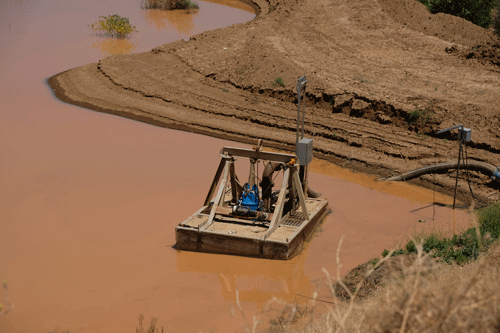
No industry puts its pumps through the wringer quite like mining. When the price of sought-after commodities, such as gold, spikes in the short term, there is no time to lose. Companies must act fast to extract whatever they can as quickly as possible. While this boost in activity is great news for stockholders, it is not exactly ideal for equipment. Many pumps end up falling prey to many problems ranging from corrosion to being crushed by heavier machinery.
To fully protect mine dewatering pumps, consider these six common threats pumps may encounter during mining operations and ways to counter the challenges.
1. Suspended Solids
The most prevalent cause of mine dewatering pump failure is clogging from gritty, suspended solids and slurry. Water that makes direct contact with the operation is often dirty, containing foreign materials, such as drill cuttings or solids generated by underground ramp traffic. When combined with the clean water that is removed from an aquifer, the result is a slimy texture that can clog pumps. One method of overcoming this challenge is proper sump design. A sump can use pits at differing elevations to collect and separate heavy solids. Removing heavy solids spares the pump from damage due to clogging and abrasion. If sump design is out of the question, one can use a pump with solids handling features, such as agitator impellers, abrasion-resistant coatings and lip seals to prevent solids from contacting the mechanical seal.
2. Corrosion
The fluids in mining applications are among the most volatile that a pump can move. From superheated water laden with pyrite, iron or sand, to emulsified brine phase drilling fluid, there is no shortage of liquids that will punish a pump over time.
If a pump is constructed using solid metallurgy, the corrosion process can be slowed to a degree. Stainless steel pumps are preferred in these applications, including submersible dewatering pumps manufactured using SCS14, a cast equivalent of 316 stainless steel.
Even the hardiest equipment can succumb to corrosion, so it is important to make use of sacrificial anodes to protect specifically against galvanic corrosion, which usually occurs in saltwater. An anode made of metal with a lower electrode potential—such as magnesium, zinc or aluminum—will take the brunt of corrosion during the pump’s application, protecting the metal that composes the pump. These protection plates must be monitored and replaced before they corrode completely.
3. Impact
This is as simple as it sounds. If a pump is not kept sufficiently away from mine traffic, there is a greater risk of crushing the pump with larger, heavier equipment. Proper placement, whether when running or stored, is key and keeps a pump safely away from the mine’s material harvesting activities. It can mean the difference between getting the job done and halting everything and incurring costly pump replacements.
4. Overheating
Overheating can occur in any pump application and mining is no different. If water levels are too low in the sump during prolonged operation and the unit’s control panel lacks any sort of overload protection, the pump will run dry and overheat.
Suspended solids also can cause overheating by accumulating in the cooling chamber and, if concentrated enough, around the motor frame. Suspended solids are another reason to carefully monitor water levels and make sure dirty water is kept separate from clean water.
5. Cord Damage
When a pump’s power cord is cut or otherwise damaged, water can pass into the copper conductors through the point of cable entry and wick back to the motor. This will lead to motor failure or a short circuit in the cable. Pulling on the cord during improper lifting or moving of the pump is often the culprit.
This kind of cord damage is a symptom of hasty mining operations and results in costly repairs. Careful handling of pumps
is necessary to keep cable entry intact. Many pump models have cable relief protection and potted cable entrances to prevent wicking.
6. Unexpected Culprits
While this may surprise some, about 20% of all mining pump failures stem from clogs caused by everyday materials.
Chief among these culprits are earplugs, which all workers need and often discard, and assorted types of fibers, such as the steel fibers used to reinforce shotcrete and blasting wire, which can wrap around the pump’s impeller. All these materials are ubiquitous in mines, which makes them more likely to cause clogging issues. If improperly discarded, any of these items can jam a pump’s impellers. It is not uncommon for a mining operation to send a pump to a distributor for repair, only to discover that improperly discarded debris has caused the unit to fail.
Mitigate Abuse
Many advancements in pump technology can mitigate the abuse pumps face in a mine, such as anti-wicking cable
entries, silicon carbide mechanical seals or high chrome impellers. These six hazards listed can befall even the most reliable equipment.
By taking the time to safeguard an operation from these common, simple mistakes—preferably with assistance from engineers throughout the job’s life cycle—mining operations can extend the life span of mine dewatering pumps past what is expected in a demanding application.

